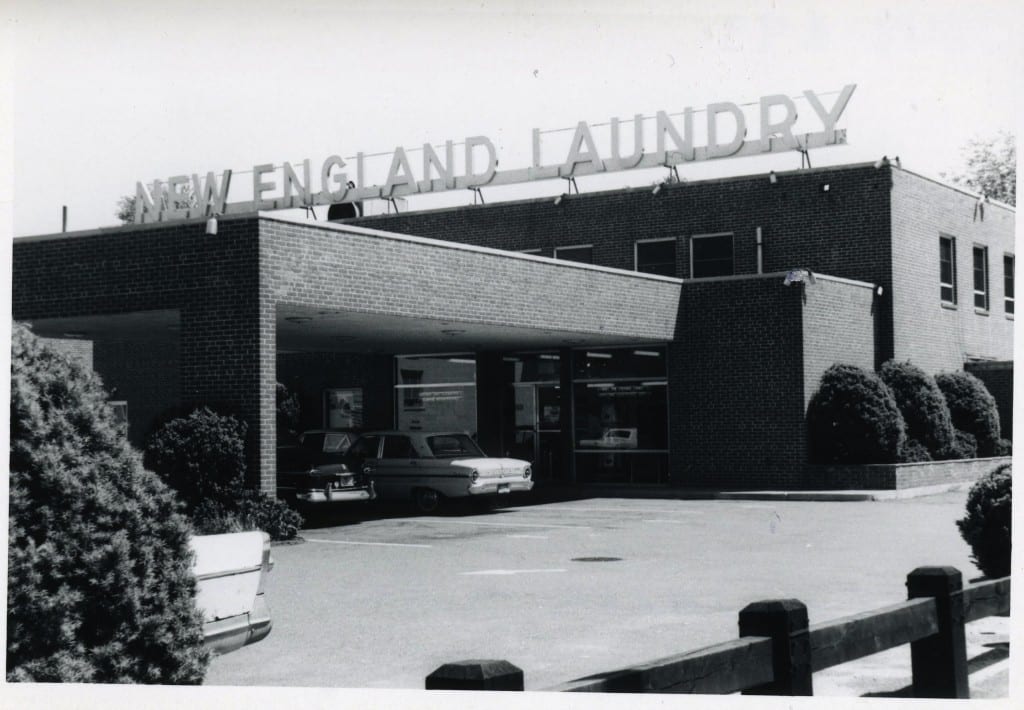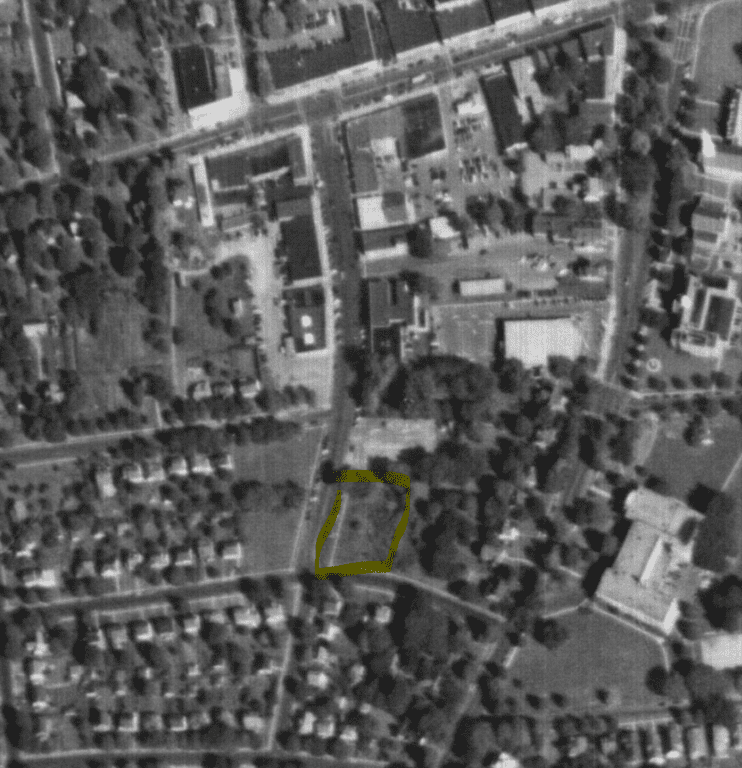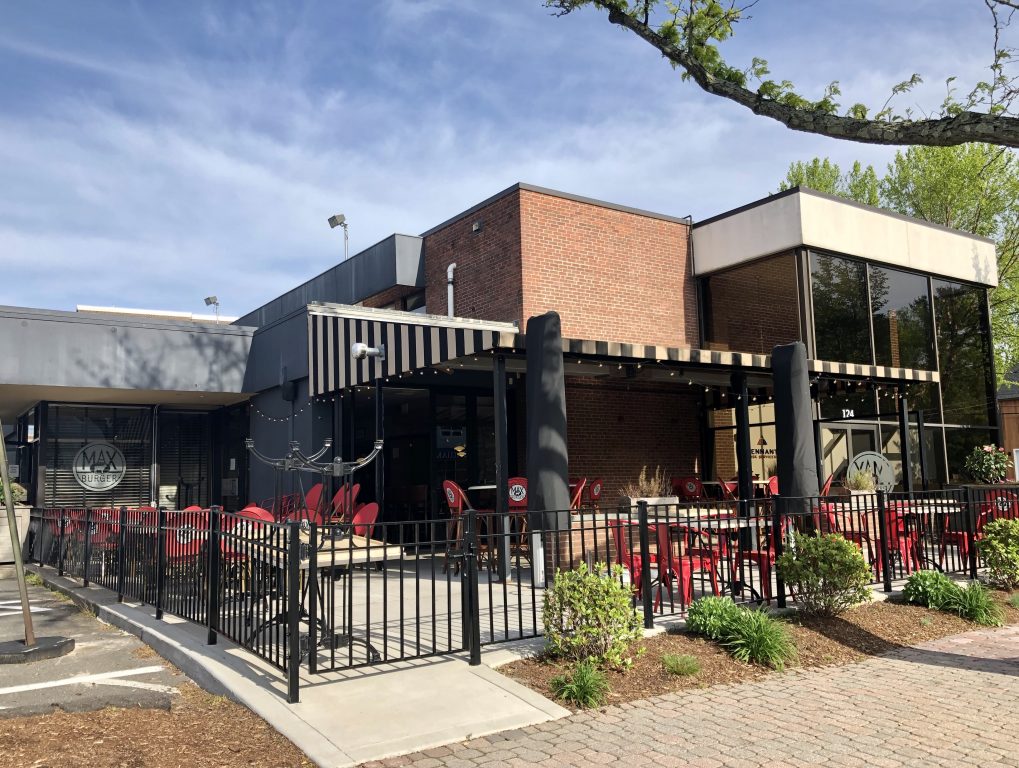From the West Hartford Archives: The Fight for New England Laundry, LaSalle and Ellsworth

Audio By Carbonatix

New England Laundry in 1966. Photo courtesy of Noah Webster House & West Hartford Historical Society
Historian Jeff Murray takes a look into West Hartford’s past to uncover some surprising information, stir up some memories, or reflect on how much life has changed – or hasn’t changed at all. Enjoy this week’s ‘From West Hartford’s Archives’ …
By Jeff Murray
The block between LaSalle Road, Ellsworth Road, South Main Street, and the extension of Memorial Road has always been the subject of controversy over land use, but the battle for the New England Laundry is one of the turning points in the history of West Hartford Center.
In September 1952, the New England Laundry Company bought the land at the northeast corner of LaSalle Road and Ellsworth Road from the homeowners along South Main Street. They petitioned the Town Plan Commission for approval of a two-story office and pick-up station there, which would require rezoning the land to a business zone.
Councilmen P. Corbin Kohn and H. Randall Pease, Jr. were in favor of many bold moves during the early 1950s that would stop the expansion of the business zone of West Hartford Zone southward. Since the 1930s, businesses had steadily crept south, creating traffic issues and an overall shadow over the nearby Hall High School. Some businesses, like Burnham’s grocery store, were grandfathered in, but new establishments threatened the “country town” vibe, even if it brought economic growth after World War II.
Kohn wanted the town to buy the Pasquale Sinatro property on LaSalle to cap new businesses and extend Arapahoe Road through to South Main Street to create a physical barrier and help traffic flow. He was in favor of connecting the Center roads with an entrance to the proposed East-West Highway (I-84 more than a decade later) in order to “drain Center traffic off Farmington Avenue before it poses a more serious problem.”
When New England Laundry petitioned for approval of their business south of where some on the town government looked to stop business expansion, some members of the commission, like Kohn and Pease, proposed buying the land proactively to stop them from setting up shop. In the first vote, the commission was deadlocked on what to do with the site. One of the members disqualified himself because he lived directly across the street from the proposed land, making it a 2-2 tie with no one to break it. The newest member to the commission the next month also disqualified himself after an attorney for the New England Laundry argued that he had publicly stated his opposition to the business expansion south a year prior (and therefore he could not be impartial).
It is important to consider that while this was an important issue for the development of the town in 1952, the bigger story at the time was the battle for Bishops Corner raging up north. Tensions ran high across West Hartford about the direction of development in an era of economic wealth and prosperity.
After the petition was referred to the Town Council (and then kicked back to them), the Town Plan Commission took another vote, this time with an elector appointed to break the tie – 3-2 to deny the rezoning petition. The company quickly appealed to the Town Council to intervene and it came up for a second time a few months later.
The Town Council held a significant meeting on March 25, 1953, when it addressed Bishop’s Corner, the Arapahoe Road extension, and the New England Laundry site. They voted 4-3 to extend Arapahoe Road to South Main Street and 3-2 to reject the New England Laundry. In response, the company withdrew their application for rezoning the site to business.
This may have been the end for this corner, but within a week, the company was at the drawing board and came back again. President Arthur C. Stevens said “We bought the land to use it, not for resale or to have it lie idle.” The battle continued – the Engineering Department prepared plans to widen Ellsworth Road from 50 to 60 feet and round the corner, which would chip away at the Laundry site. The Arapahoe Road extension east was put on hold by May 1953 after strong opposition from proponents of business expansion and some nearby homeowners.
Overall, the round table featured horse-trading and haggling on a grand scale.
That fall, the Ellsworth Road widening project went ahead and by December 1953, after the results of the Ellsworth project were known, the Laundry officially petitioned for the office and station, the third time this would come up in a year. Some argued that the business expansion through the old homes on South Main Street was simply inevitable and that the tax revenue was needed, even at the expense of nearby home values.
The company pushed harder this time in its messaging campaign – they gave all sorts of reasons why the business at this corner would essentially run like a residence and therefore cause no disruptions to traffic or the neighborhood. A few members on the Council called the campaign “window dressing and sugar coating” and argued that acting right then to stop the business expansion was necessary to prevent future problems.
On Dec. 14, 1953, the Town Plan Commission denied the company’s request in another 3-2 vote. As West Hartford entered 1954, the company appealed to the Town Council. An interesting argument was given that now that the town approved widening Ellsworth Road (which chipped away at the Laundry site), they should expect business traffic. This time, the Town Council voted in favor of the petition in March 1954, and the New England Laundry began building their office.

Aerial map of the vacant lot at the corner of LaSalle Road and Ellsworth Road in 1952.
Opening in early 1956, this drive-in branch complemented the main plant at the corner of Homestead Avenue and Albany Avenue in Hartford (this building was demolished just under 15 years ago and remains vacant today). The opening featured a push-button conveyor belt to bring clean clothes to the front for quicker service, a perfect example of the kind of technology-driven consumerism that was so popular in the 1950s.
The featured photograph was taken in June 1966, just ten years after it opened (and it was taken to document a zoning violation regarding the signage on top). Ironically enough, for how much effort it took to get approval, the Laundry did not stay on the property all that long. In 1970, the corner was bought by Mechanics Savings Bank for $300,000. The bank was here for more than double the time that the Laundry was and the offices upstairs were rented out to other tenants.
In 1999, Webster Bank acquired the local Mechanics and closed almost all of the branch offices. The LaSalle Road location was a victim of this consolidation due to its proximity to a Webster branch.
A few months after, in the fall of 2000, the site was purchased for $1,050,000 by the insurance firm Bouvier, Beckwith & Lennox (the current owners) and the fight began again over which business should occupy the premises. Restaurants swooped in to court the owner (one of the partners in the firm was then-West Hartford Mayor Robert Bouvier) and the winner was Azul.
By 2003, outdoor dining was allowed and residents voiced complaints of increased traffic and parking hassles, but there was nothing to be done. Then came the Simmer Grille in 2006 and finally Max Burger in 2009, which is still there after 15 years. The building is nearly the same as when it was built.

Current site of Max Burger at 124 LaSalle Rd., corner of Ellsworth Road. Photo credit: Ronni Newton (we-ha.com file photo)
Unfortunately for the residents around LaSalle Road, the battle against business was lost 70 years ago. But the lesson is that even in the prosperous 50s, many people were angry about the direction the town was heading.
I made a similar comparison in an article from last year on Bishops Corner and I pose the same question today: many of the changes happening around town today will have long-term consequences, but many will not be seen until much later. What will the people of West Hartford in the 2090s think of what we did here in this decade? Like our opinions of the 1950s, there will be some comments about the 2020s, but maybe they won’t think about any of this at all.
Jeff Murray was born and raised in West Hartford and has been involved with the Noah Webster House & West Hartford Historical Society since 2011 when he was a high school student and won the Meyer Prize for his essay on local history. Jeff routinely volunteers as local history researcher uncovering information for numerous museum programs such as the West Hartford House Tour and West Hartford Hauntings. Jeff works as a data analyst at Pratt & Whitney.
Like what you see here? Click here to subscribe to We-Ha’s newsletter so you’ll always be in the know about what’s happening in West Hartford! Click the blue button below to become a supporter of We-Ha.com and our efforts to continue producing quality journalism.



